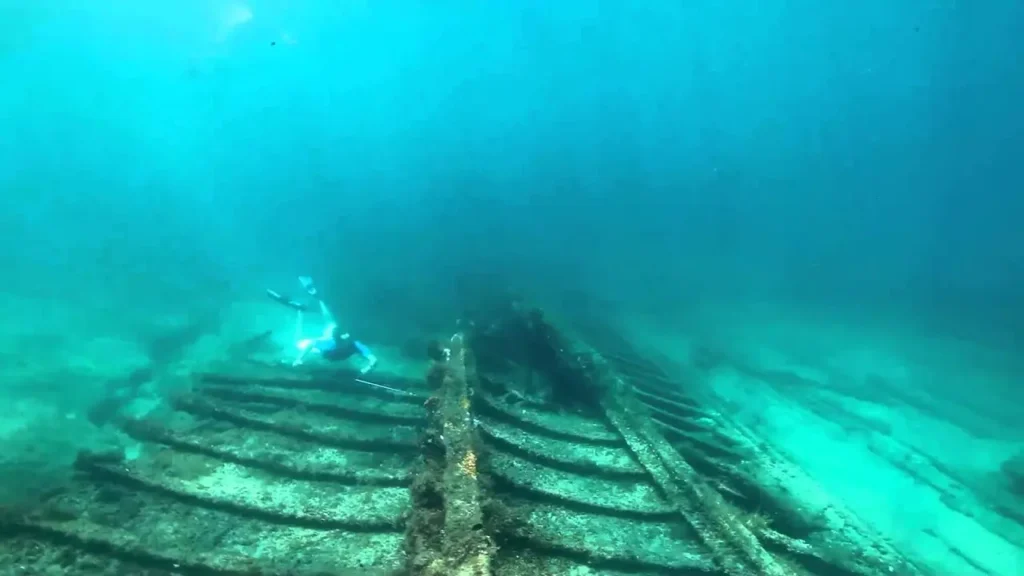
- Importance of Underwater Archaeology
- Brief Overview of Lofthus Underwater Archaeological Preserve
- Sinking of the Lofthus
- Discovery and Preservation
- Unique Artifacts and Features
- The Significance of Findings
- Initial Restoration
- Ongoing Conservation Activities
- Visiting Rules and Guidelines
- Opportunities for Divers and Tourists
- Contributions to Archaeological Research
- Impact on the Preservation of Maritime Heritage
- Planned Projects and Research
- Potential Challenges and Solutions
Importance of Underwater Archaeology
Underwater archaeology plays a crucial role in unveiling the hidden mysteries of our past. Exploring submerged sites like the Lofthus Shipwreck not only broadens our understanding of maritime history but also helps in the preservation of valuable artifacts for future generations, providing a context for historical events and civilizations.
Brief Overview of Lofthus Underwater Archaeological Preserve
Nestled in Florida’s serene waters lies a realm ripe for exploration: the Lofthus Underwater Archaeological Preserve. It is home to the remnants of the ship ‘Lofthus’, which sank in 1898. This historical underwater park allows visitors to delve into the depths of history while relishing the enchanting aquatic world.
Historical Background
Sinking of the Lofthus
In the frigid winter of 1898, the ship Lofthus met an untimely end off the shore of Florida’s Manalapan area. The Norwegian vessel, designed for the China tea trade but later repurposed for cargo transport, was en route from Pensacola to Buenos Aires when it was caught in a devastating storm. Marooned near Boynton Beach, efforts to salvage her proved unsuccessful due to the treacherous weather conditions and the weight of her cargo. Despite adverse conditions, the brawny Lofthus held itself intact, sinking slowly until it finally vanished beneath the waves, marking the beginning of its underwater journey.
Discovery and Preservation
The historic Lofthus Shipwreck was first discovered in 1909 off Manalapan, Florida. As an underwater archaeological site, it underwent numerous evaluations before being recognized and placed on the National Register of Historic Places in 2001. The shipwreck carries abundant relics from the late 19th century, making it a unique and valuable underwater museum.
The preservation activities primarily include regular monitoring and periodic surveys carried out by scientists, historians, and volunteers. Alongside monitoring, measures like buoys marking the boundaries are implemented to prevent unauthorized intrusions, ensuring the site’s preservation for future generations interested in history and undersea exploration.
Related: The Mind Blowing Story Of The Half Moon Underwater
Archaeological Findings
Unique Artifacts and Features
In the heart of the Lofthus Underwater Archaeological Preserve lie distinct treasures and peculiarities that narrate a captivating story of historical significance. The key highlight of this preserve is the remnants of the shipwreck, ‘Lofthus’, a vessel that met an unfortunate end in 1898. One may encounter the vestiges of the wooden frames and iron infrastructure of this 19th-century ship, showcasing unique construction techniques of that era. Divers will appreciate the abundant marine life taking shelter in and around these ruins, effortlessly blending natural splendor with historical intrigue.
Ceramic fragments, maritime tools, and personal items of the ship’s crew have been carefully recovered, showcasing a pristine glimpse into the life and times aboard the ship. Furthermore, the preserve’s guarded environment allows the artifacts to lay undisturbed, offering not just a dive site but a time capsule for archaeologists and enthusiasts alike. These relics serve as tangible evidences, shedding light on the maritime history and contributing meaningfully to the scientific research and education.
The Significance of Findings
The findings at Lofthus Underwater Archaeological Preserve have enhanced our understanding of maritime history significantly, showcasing the intricacies of 19th-century ship construction and trading practices. Particular attention has been drawn to the ruins of the ship Lofthus, which ran aground in 1898. Excavation has yielded several artifacts including barrel hoops, wooden decking elements, iron fasteners and rigging materials, enhancing insight into the shipbuilding techniques of the era.
Further, an array of domestic items such as ceramics, glassware, and utensils shed light on the lives of the crew members. These artifacts provide a tangible connection to the past and serve as time capsules encapsulating the cultural, economic, and social conditions of the time. Hence, the findings at the preserve are not just significant for historians and archaeologists, but for modern society as a whole, underlining the importance of maritime heritage and inspiring a sense of connection with the past.
Conservation Efforts
Initial Restoration
The early phase of preservation, set in motion, was a labor-intensive endeavor involving a team of dedicated professionals and enthusiastic volunteers. Damages, mainly caused by exposure to harsh marine conditions and human interference, were meticulously examined, documented and addressed. Strategies were devised to stabilize and conserve the wooden structure, which was delicately cleaned of marine growth. At the same time, non-invasive methods were employed to ensure the minimum disturbance to the surrounding aquatic ecosystem.
Archaeologists worked closely with conservationists to determine the best preservation techniques, ensuring each artifact’s integrity. Moreover, the application of preservatives to prevent further degradation and corrosion of metallic objects was a significant part of the process. This stage laid a solid foundation for the establishment of Lofthus Underwater Archaeological Preserve, a project where history meets conservation.
Ongoing Conservation Activities
At the heart of the Lofthus preservation endeavors, a myriad of conservation activities are consistently in motion. These include continuous monitoring and assessment by professional archaeologists who carefully analyze the site to protect and preserve the remnants of the ship and its cargo. Innovative digital technologies such as 3D imaging and photogrammetry are often utilized for comprehensive site documentation.
Another significant aspect of the conservation efforts includes conducting regular cleaning operations to eliminate marine growth and reduce the risk of biological damage. Educating the public through informative tours and workshops also forms a crucial part of these endeavors, as raising awareness and promoting heritage preservation supports long-term protection. Additionally, the introduction of mooring buoys has been beneficial in preventing unwanted anchor damage, thereby further bolstering preservation efforts.
Public Access and Regulations
Visiting Rules and Guidelines
If you’re planning to explore the Lofthus Underwater Archaeological Preserve, adherence to specific regulations is a must. First and foremost, remember this area is protected by law, and it is illegal to disturb the ecosystem or take artefacts. Divers should avoid contact with the remnants to prevent any potential damage. Furthermore, visibility may not always be optimal, so it is advised to only venture underwater with a dive flag during daylight.
Park rangers may offer guided tours, providing a unique opportunity to dive into history while maintaining safe practices. Lastly, verify that you’re fully insured and equipped with suitable gear before embarking on your dive. With your commitment to these guidelines, the preserve can remain a cherished destination for generations to come.
Opportunities for Divers and Tourists
Delving into the depths of this majestic underwater preserve offers a unique experience for both divers and tourists. It’s an unparalleled opportunity to witness history frozen in time, amidst a rich marine life habitat. Visitors are allowed to dive at the site with certain prerequisites: they must hold a valid diver certification, abide by the preserve rules and respect the sanctity of the artifacts.
Additionally, special snorkeling tours are arranged for non-divers who wish to explore these underwater treasures. Information boards on-site provide enlightening details about the shipwreck’s history and its diverse marine life. Aspiring to conserve this submerged heritage, the Preserve solicits visitors’ involvement in maintaining its pristine nature, making it more than just a tourist attraction; it’s also an educational and conservation initiative.
The Role of Lofthus In Marine Archaeology
Contributions to Archaeological Research
The Lofthus preservation area has enormously expanded the field of marine archaeology, providing a wealth of invaluable data. Scuttled in 1898, this shipwreck site serves as a living museum, offering a snapshot of 19th-century shipbuilding techniques and naval history. Analysts have had the opportunity to study its well-preserved hull and cargo, discovering more about material culture during the time it was operational.
Moreover, observations from the site have provided learnings on how objects decompose underwater over time. Thus, the Lofthus site’s unique offerings have both advanced our understanding of the past and brought fresh directions for future marine archaeological explorations.
Impact on the Preservation of Maritime Heritage
Lofthus Underwater Archaeological Preserve offers a unique platform for researching and conserving maritime heritage by presenting an undisturbed snapshot of 19th-century shipbuilding. As one of the few submerged archaeological sites accessible to the public, it encourages community participation in preserving history, raising awareness about the importance of marine archaeology.
The Lofthus serves as an excellent educational model for illustrating heritage management practices and underwater archaeological techniques. Its preservation has enhanced significant understanding of historical seafaring and maritime trade patterns, contributing substantially to the broader field of maritime heritage studies and conservation efforts. The Lofthus remains an invaluable resource for presenting maritime history to new generations.
Future Directions
Planned Projects and Research
In a bid to augment our understanding of this submerged treasure, several endeavors are underway. Collaborations are commencing with eminent historians and marine archaeologists to enlighten us about the life and times of Lofthus through more in-depth research. A significant initiative is the development of a virtual reality (VR) tour, providing enthusiasts an immersive diving experience from their homes.
This project aims to foster greater appreciation and awareness of the preserve. Additionally, educational outreach programs targeting schools and local communities are on the cards, nurturing their interest. By emphasizing scientific exploration and public education, we intend to ensure the preserve’s ongoing relevance and preservation.
Potential Challenges and Solutions
Navigating the complexities of underwater excavation at Lofthus site presents notable challenges. Unpredictable sea conditions, marine life interference, and equipment malfunctions can complicate the process. However, advancements in marine archaeology have proposed solutions to these problems. High-tech diving gear and precise excavation tools can overcome physical hindrances, and artificial intelligence can predict and mitigate environmental concerns like changing tides or currents.
Also, collaborations with marine biologists could manage local ecosystem disturbances. The adoption of these advancements can ensure a more detailed and accurate analysis of the submerged historical treasure, paving the way for an all-encompassing exploration in the future.



